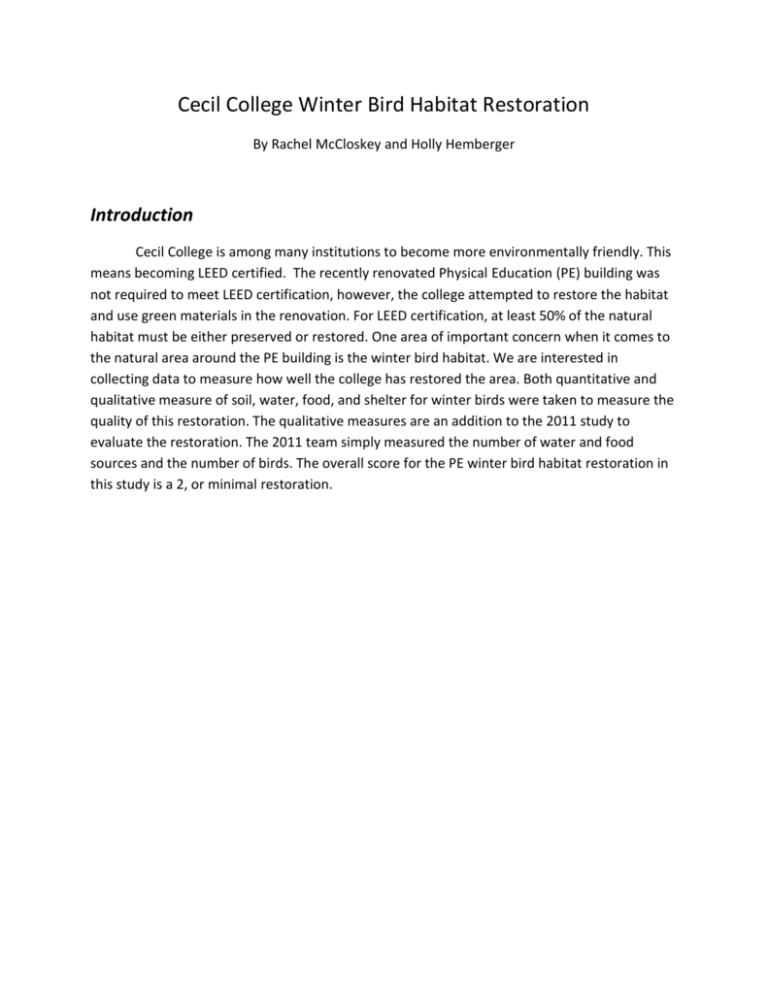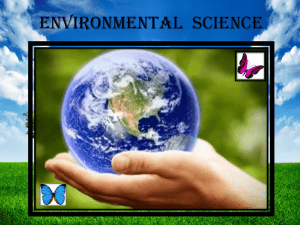Cecil College Winter Bird Habitat Restoration
advertisement

Cecil College Winter Bird Habitat Restoration By Rachel McCloskey and Holly Hemberger Introduction Cecil College is among many institutions to become more environmentally friendly. This means becoming LEED certified. The recently renovated Physical Education (PE) building was not required to meet LEED certification, however, the college attempted to restore the habitat and use green materials in the renovation. For LEED certification, at least 50% of the natural habitat must be either preserved or restored. One area of important concern when it comes to the natural area around the PE building is the winter bird habitat. We are interested in collecting data to measure how well the college has restored the area. Both quantitative and qualitative measure of soil, water, food, and shelter for winter birds were taken to measure the quality of this restoration. The qualitative measures are an addition to the 2011 study to evaluate the restoration. The 2011 team simply measured the number of water and food sources and the number of birds. The overall score for the PE winter bird habitat restoration in this study is a 2, or minimal restoration. Quantitative Methods Description of scoring methods: 1. Poor restoration No sources of food (0) No water sources available or all toxic by EPA drinking water standards No top soil in tested areas Avian biodiversity score greater than 0.8 2. Minimal restoration Minimal food sources (1 available source) One water source present to sustain winter bird life that is within EPA drinking water standards, all others toxic Little top soil in tested areas (1-2 inches average) Avian biodiversity score greater than or equal to 0.6 and less than 0.8 3. Fair restoration Adequate amount of food sources (2 different available sources) Two water sources present to sustain winter bird life that are within EPA drinking water standards, others toxic Suitable amount of top soil in tested areas (3-4 inches average) Avian biodiversity score greater than or equal to 0.4 and less than 0.6 4. Good restoration Good amount of food sources (3 different available sources) Three water sources present to sustain winter bird life within EPA drinking water standards Good amount of top soil in tested areas (5-6 inches average) Avian biodiversity score greater than or equal to 0.2and less than 0.4 5. Excellent restoration Three food sources with birds involved in feeding behavior Three water sources present within EPA drinking water standards with birds observed utilizing water sources Excellent amount of top soil in tested areas (6+ inches average) Avian biodiversity score less than 0.2 Data from Measurements for Habitat Quality Building construction destroys soil by stripping the land of top soil, or Horizon O and A, leaving only sub soil. Even though soil is supposed to be replaced to some extent after construction, top soil can also be washed away if the building causes a problem with run off. Sub soil is hard and not particularly suitable for bird shelter and top soil is required to make nests. The quality of water sources can also be compromised by runoff. Different chemicals in rain water that are washed from buildings, sidewalks, and parking lots and roads can contaminate water, bringing the pH outside a safe drinking range. The EPA recommends that drinking water be kept at a pH between 6.5 and 8.5 to be safe. These parameters will be used to determine whether water sources are safe or not for the birds. To take soil samples, we started immediately adjacent to the water source from the building side, and then measured sections four meters long from the water source to the edge of building, and took soil samples at each section. The pH was also tested by using pH strips. Waste was measured by counting the number of visible debris in the area immediate to the water source. Table 1: Measurement Data from Water Source A Water source A is a small natural seep just downhill from the PE building, immediately adjacent to the woods. pH: 6.2 (slightly low) Waste: about 10 pieces around source Distance from water Horizon O(in) source(m) 4 0 8 0 12 0 Horizon A(in) Sub-soil 0 0 1 All sub soil All sub soil Mostly sub soil Distance 12 meters was the only measurement that had any top soil whatsoever. The soil around this water source is not suitable for usage by winter birds for habitat. Table 2: Measurement Data from Water Source B Water source B is a larger pond towards the back side of the building. The water is a bit murky. pH: 6 (low) Waste: none Distance from water Horizon O(in) source(m) 4 1 8 0 12 0 16 1 Horizon A(in) Sub-soil 1 1 1 6 Mostly sub soil Mostly sub soil Mostly sub soil Sub soil farther down The average amount of top soil (including both horizon O and horizon A) is 1.57 inches for the seven different samples. There were only two water sources, both with pH both outside the safe drinking water parameters. Winter 2011 – Bird Observation Data Birds in winter 2011 were observed with binoculars 8 by 40 with the aid of Birds of North America to identify the bird. There were four students observing. The distance from which most of the birds were observed was about 10 meters. Observation Dates: 2/14/2011 : Partly Cloudy, 36 degrees Fahrenheit, Winds 5-10 mph o Ground Cover: Snow. Approx. 4-6 inches deep o Time : 4:15 pm - 5:45pm 2/21/2011 : Cloudy, 34 degrees Fahrenheit, Winds 10-15 mph o Ground Cover: Snow. Approx. 4 inches deep o Time : 4:15 pm - 5:45pm 2/28/2011 : Mostly Sunny, 40 degrees Fahrenheit, Winds light and Variable o Ground Cover: Snow. Approx. 2-4 inches deep o Time : 4:15 pm - 5:45pm Winter 2012 – Bird observation Data Observation Dates: 2/1/2012: Clear, 62 degrees Fahrenheit, Winds light and Variable o No ground cover o Time: 2:15 pm – 4:30 pm 2/22/12: Cloudy, 57 degrees Fahrenheit, Winds light and Variable o No ground cover o Time: 3:30 – 4:15 In 2012, although we spent time observing, we did not see any winter birds utilizing water or food source, nor flying. This, however, does not affect the Avian Biodiversity scale that was made from the winter 2011 team, which was calculated by: Equation used for Simpson’s index: D = (n / N)2 Table 3: Data Used to calculate Simpson’s index of biodiversity Species DEJO WTSP NOCA RSHA SOSP N n 10 10 2 1 13 36 Simpson’s Avian Biodiversity Score: DEJO: (10/36)2 = 0.077 WTSP: (10/36)2 = 0.077 NOCA: (2/36)2 = 0.003 RSHA: (1/36)2 =0.00077 SOSP: (13/36)2 =0.1304 D= 0.288 Food Sources: Because no food sources were observed being used by any winter birds during the winter 2012 observation dates, no food sources were recorded. Conclusion: Scores for Variables Based on Collected Data Food Sources: 1 No food sources were identified in this study. None were seen being utilized by birds. Therefore, this meets the poor restoration standard and receives a score of 1. Water Sources: 1 Although there were two water sources, both were outside the EPA’s drinking water standards and are therefore considered unsafe for scoring purposes, and this also receives a score of 1, meeting the poor restoration standards. Soil Quality (for Shelter Material): 2 The average top soil amount was 1.57 inches, which meets the requirements for minimal restoration. Runoff could have caused this average to be low, as the runoff from the Physical Education building is rather bad. The runoff may have also caused the low pH of the two water sources. Avian Biodiversity: 4 Bringing in the bird counts from the 2011 winter bird study, the Avian Biodiversity score remains unchanged even though no birds were seen this season. The score of 0.2888 meets the requirements for good restoration, and a score of 4. Overall Restoration Score: 2 (minimal) The data in this study provides further insight into the conditions of the winter bird habitat surrounding the Physical Education Building at Cecil College. The low score of 2, or minimal, is unacceptable for a campus striving for LEED Certification. However, further study is still required to gain a complete understanding of the restoration quality and what needs to be done to better restore the area to be friendly to both students and winter birds. Works Cited LEED® for New Construction & Major Renovations. Oct. 2005. 15 Feb. 2012. <http://www.usgbc.org/ShowFile.aspx?DocumentID=1095>. "Secondary Drinking Water Regulations." EPA. United States Environmental Protection Agency. Web. 15 Feb. 2012. <http://water.epa.gov/drink/contaminants/secondarystandards.cfm>. Geiser Z., Meckley M., Panaro J., Ramirez L. “Cecil College: Winter Bird Habitat Restoration.” Feb. 2011. 8 Feb. 2012.






